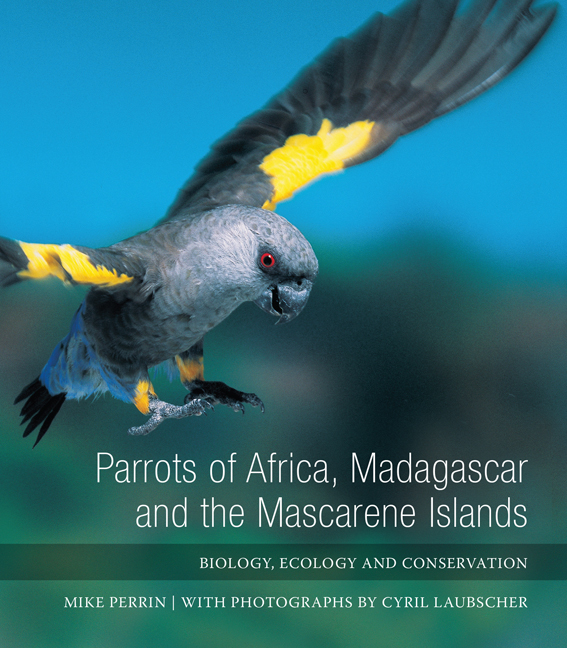Book contents
- Frontmatter
- Contents at a glance
- Contents
- Acknowledgements
- List of tables
- List of figures
- Abbreviations
- Chapter 1 Introduction
- Chapter 2 Conservation Biology
- Chapter 3 Systematics
- Chapter 4 Biogeography and Niche Separation
- Chapter 5 Intelligence, Communication and Behaviour
- Chapter 6 Breeding Biology
- Chapter 7 Diet and Metabolism
- Chapter 8 Case Study – The Cape Parrot
- Chapter 9 Trade in African parrots
- Chapter 10 African Parrot Conservation
- THE PARROT SPECIES OF AFRICA
- IUCN CATEGORIES
- Chapter 11 Long-Tailed and Fossil Parrots
- Chapter 12 True Parrots
- Chapter 13 Lovebirds
- Chapter 14 Field Techniques in Parrot Research
- Species lists
- Glossary
- Bibliography
- Index
Chapter 4 - Biogeography and Niche Separation
Published online by Cambridge University Press: 04 June 2019
- Frontmatter
- Contents at a glance
- Contents
- Acknowledgements
- List of tables
- List of figures
- Abbreviations
- Chapter 1 Introduction
- Chapter 2 Conservation Biology
- Chapter 3 Systematics
- Chapter 4 Biogeography and Niche Separation
- Chapter 5 Intelligence, Communication and Behaviour
- Chapter 6 Breeding Biology
- Chapter 7 Diet and Metabolism
- Chapter 8 Case Study – The Cape Parrot
- Chapter 9 Trade in African parrots
- Chapter 10 African Parrot Conservation
- THE PARROT SPECIES OF AFRICA
- IUCN CATEGORIES
- Chapter 11 Long-Tailed and Fossil Parrots
- Chapter 12 True Parrots
- Chapter 13 Lovebirds
- Chapter 14 Field Techniques in Parrot Research
- Species lists
- Glossary
- Bibliography
- Index
Summary
AVIAN COMMUNITY STRUCTURES IN AFRICA
Africa is second in area to Eurasia and covers 30 million km. It boasts an impressive array of habitats from vast deserts, extensive savannas and grasslands, to mountain ranges, wetlands and tropical forests. Within the Afrotropical region there are islands ranging in size from small (Rodrigues) to large (Madagascar). Africa supports the world's second largest assemblage of bird species after South America. The mainland and its associated islands maintain almost 2,400 (24%) of the world's 9,946 species. The parrots, however, represent significantly less than 10% of the world's parrots (24 of the approximately 330 species). Globally, some parrot species are confined to small oceanic islands, while others have wide distributions on the mainland. Until 270 mya, Africa formed part of the southern supercontinent of Gondwanaland, but by 100 mya, the present continents had separated from one another. Great changes in the environment, landscapes and habitats occurred through wet and dry phases, with the alternating expansion and contraction of forests and arid grasslands. This created opportunities for adaptive radiation, but there are surprisingly few parrot species in Africa.
In addition to natural changes, there has been severe environmental change and degradation caused by humankind. For parrots, the loss of forests has likely been the most significant. The rapidly dwindling forests of West Africa, those of the south and along the east African coast and adjacent interior, are home to some of the threatened parrots and lovebirds. As these trends intensify, more species will be lost.
Over the past half-century, 46 new bird species have been described from Africa (Stuart & Stuart 1999). These include species discovered and described for the first time and still others separated from previously known species on the basis of clear genetic and morphological techniques (for example, the Cape Parrot). Africa has been the centre of speciation and evolution of several taxa, likely including bustards, pratincoles, sandgrouse, bee-eaters, hornbills, honeyguides and some larks, and hosts nine endemic families (ostrich, shoebill, hamerkop, mousebirds, whydahs, secretary bird, guineafowl, woodhoopoes and the turacos). Madagascar and the Mascarene Islands also support a very significant avifauna, with five endemic bird families (Stuart & Stuart 1999).
- Type
- Chapter
- Information
- Parrots of Africa, Madagascar and the Mascarene IslandsBiology, Ecology and Conservation, pp. 83 - 102Publisher: Wits University PressPrint publication year: 2012



